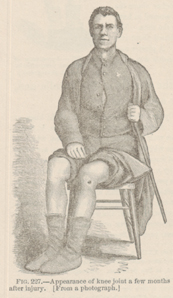Title: Golden, D.
Source text: The Medical and Surgical History of the War of the Rebellion. (1861-65.), Part 3, Volume 2 (Washington, DC: Government Printing Office, 1883), 374.
Civil War Washington ID: med.d2e15292
TEI/XML: med.d2e15292.xml
CASE 556.—Corporal D. Golden, Co. M, 14th New York Artillery, aged 33 years, was wounded at Petersburg, June 17, 1864. He was admitted to the field hospital of the 1st division, Ninth Corps, where Surgeon M. K. Hogan, U. S. V., noted: "Wound of left knee by minié ball; simple dressings applied." From the field the wounded man passed to the Depot Hospital at City Point, and thence, on July 2d, to Harewood Hospital, Washington. Surgeon E. B. Bontecou, U. S. V., in charge of the latter, described the injury as "a wound through the patella," and reported that the patient was discharged from service April 14, 1865, for total disability. Examiner C. C. Bates, of Potsdam, N. Y., April 29, 1865, certified: * * "He can flex but cannot extend the leg, except enough to touch the toe to the floor. Thigh and leg much atrophied; knee much swollen and painful. Examiner G. R. Baldwin, of Fort Scott, Kansas, reported November 13, 1877: "The pensioner received a wound of the left knee. The ball entered at the lower border of the patella, passed outward and upward, and made its exit at the outer border of the patella. Synovial fluid escaped. There is a large, irritable, and tender cicatrix. The patella is immovably attached to the tibia. The leg requires rest, motion and strength being very much impaired. Pain is a prominent symptom." The pensioner was paid September 4, 1879. A photograph (Card Photographs, Vol. I, p. 17), represented in the annexed wood-cut (FIG. 227), was contributed by Surgeon R. B. Bontecou, U. S. V.
